Month: April 2015
The Life of a Bard’s Biggin’
In celebration of his birthday this week, we have decided to focus on another great bard: William Shakespeare. The works of Shakespeare were a significant influence on Robert Burns, for he is known to have owned and read Shakespeare’s works, and often quoted the writer in his letters. However, today, we have decided to go down another avenue, and instead of looking at the writings of the two bards, we are going to look at how their fame impacted the life of their birthplaces.
The two birthplaces in this story began life very differently. Shakespeare’s house was a large 3 storey Tudor building, suitable for the wealthy Shakespeare family who were successful local traders. Burns Cottage, on the other hand, despite being more modern, is the more humble of the two. Built by William Burnes, it is a simple farmer’s cot with 2 out of the 4 rooms used for farm purposes. Thus, taken at face value, our houses seem utterly different. Yet what unites them is the fact that they have become places of international veneration. Without that lasting heritage, the ages no doubt would have seen the demolition of these houses along with so many others from ages past. But how did these houses survive before their bards were so widely admired?
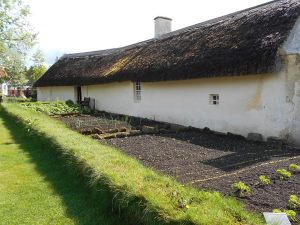
Although Shakespeare was to ultimately live in another house in Stratford, his birth home was handed to him on his father’s death and the house ultimately passed down through the family over many years. Burns Cottage on the other hand, was sold to the Shoemakers Incorporation several years after the Burnes family had left the premises. Nonetheless, regardless of whether the houses remained in family ownership, both were let out to tenants. In both cases certain tenants made the decision to run a pub, with Shakespeare’s house becoming The Maidenhead, while Burns Cottage became the Burns Heid Inn. Consequently, by changing hands and changing uses, each house underwent transformations. For example, as sight seers increased at the houses, visitors would scratch their names and messages onto wooden beams, doors, and glass windows, in order to leave a memento of their visit. Thankfully, to protect the heritage and history of these sites, the Victorian age saw both properties bought by trusts. In 1846 the Shakespeare Birthplace Trust bought Shakespeare’s house when it went on the market, while the Burns Monument Trustees bought Burns Cottage in 1880.

However, for Shakespeare and Burns lovers across the world, sometimes they have wanted something a little closer to home and, consequently, both houses have copies! In America, the Atlanta Burns Club made a club house based on Burns Cottage, while in Maruyama Machi, South Chiba, you can visit full size replicas of Shakespeare’s birthplace and Mary Arden’s farm!
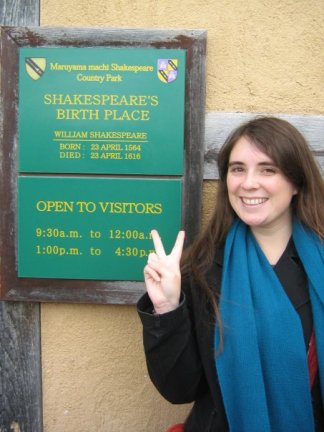
So looking at the history of our famous houses, it is surprising to see their similarities! They have been homes to many people, been pubs, changed hands, been bought to protect their heritage, and lastly they have been copied and recreated on the other side of the world, all due to the famous people who were born there!
The Bar at Burns Cottage
This May 16th, as part of the Museums at Night 2015 festivities, we are turning the clock back once more to the days when Burns Cottage was a pub. But how did the Cottage become a pub, and what was it like? Learning Intern, Mhairi Gowans, delves into the Cottage’s unusual past.
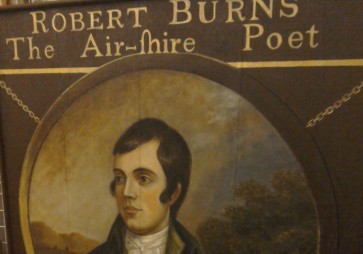
After the Burnes family left the Cottage in the 1760’s to the farm at Mt Oliphaunt, Burns Cottage (originally named ‘New Gardens’) was left vacant until William found a buyer in the Shoemakers Incorporation in 1781. Buying before the publishing of the Kilmarnock Edition, the Shoemakers managed to land themselves a bargain: what they bought for £160, they would sell for £4000 a hundred years later.
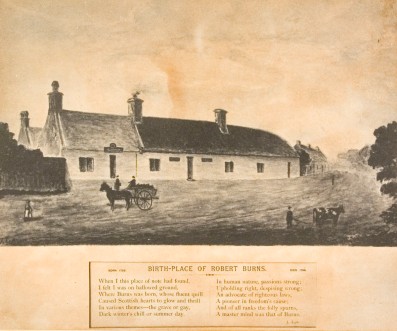
By the time of Robert Burns’s death, the Cottage was already receiving a great deal of interest and the tenant present in 1803, John (Miller) Goudie, made the decision to transform the Cottage into a pub called the Burns Head Inn, adding on a new section to the Cottage building. The first public mention of the pub comes from the Scots Magazine of 1805, which states that ‘the person who occupies it at present has turned it into a snug public house. At this house, early on the birthday of the poet, a social party meet to celebrate it with festivity.’

Festivity seems to be the word to use in regard to Miller Goudie, who appears in anecdotes as an infamous local character. For example, an Irish lawyer visiting in 1810 said he saw ‘Miller Goudie, the man that transformed it into a public house, sitting drunk in the corner where ‘the saint, the father, and the husband prayed.’ Keats said about his visit in 1818, that the innkeeper was a ‘mahogany faced old jack ass,’ while a 1904 book published by the Monument Trustees says that, ‘Goudie’s chief aims in life seem to have been pledging the Poet’s memory with anyone who would furnish him with the wherewithal to do so.’ It also said that Miller Goudie claimed to know Burns, although the writer of his obituary in the Ayr Advertiser in 1842 stated that ‘he seems to have retained but very slight recollection of the Poet. The Miller thought he was eccentric, and ‘no that richt in the head.’

Following the death of Miller Goudie, the Inn and Cottage passed through the hands of several tenants over a short period of time. One of the tenants, Davidson Ritchie, was photographed here with some notable Alloway residents. However, the Cottage’s time as a public house was coming to an end as the Monument Trustees, with aid from the Earl of Stair, bought the Cottage in 1880. However, the roaring trade of sight seers to the Burns Head Inn has left its mark in the form of graffiti. If you have ever been to Burns Cottage you might have noticed the writing on the doors: initials, names, dates, all scrawled onto the wood. If you look even closer you will also find graffiti on some of the windows: all from historic visitors wanting to write messages to their favourite poet, or to show that they had been there.
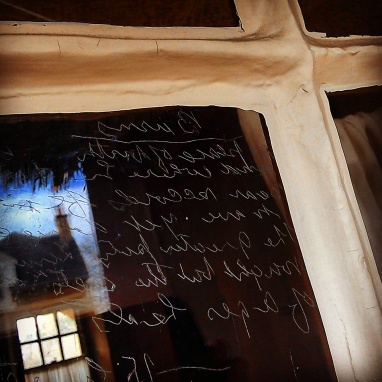
So come along to the Burns Head Inn this May 16th and while you’re toasting the Bard spare a thought for the infamous Miller Goudie!
For information and tickets for the event please click here!
A Day in the Life of a Learning Officer
Our latest edition of ‘A Day in the Life’ features our Learning Officer, Ally Beckett!
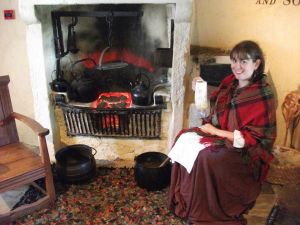
What’s the first thing you did when you arrived this morning?
The first thing I do in the morning, a little predictably, is check my emails and make a cup of coffee… or maybe two! I then double check what’s in store for the day. At this time of year we have lots of school groups in, but we may also have family events, craft activities or guided Cottage tours to do throughout the year.
Give me a brief description of your day.
In the busy January – March period we’ll have up to 4 school groups in a day, so looking after them takes up the majority of the Learning Team’s time. We have a really exciting learning programme for all ages, and doing different workshops every day keeps the variety there for us as deliverers. My favourite is the workshop which involves teaching the class to make butter in the 18th century way – the kids love it even if they do make a horrendous mess!
I also help with planning events and family activities like Burns Night and Easter. One event we’ve recently added to our repertoire is the Burns Heid Inn, recreating the period when Burns Cottage was run as a pub in the 19th Century. I love organising this event, and I am looking forward to it happening again in May.
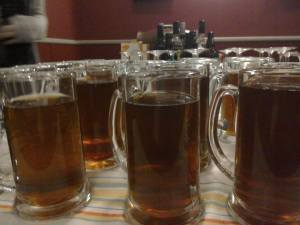
What’s your favourite thing about the job?
My absolute favourite thing is delivering the school workshops… you can always rely on children to say the funniest and most random things, and the sense of satisfaction you get when you realise a class of 30 kids have gone away at the end of the day inspired by Robert Burns is a real boost. I also love chatting to our visitors and hearing their stories. Some people come in with connections to Burns and his family, or have travelled from halfway across the world just to come and see the Cottage. It makes you realise that you can sometimes take working here for granted!
Above all, I love the variety that each day in this job brings. One day I can be dressing nursery children up as wee tim’rous beasties and showing them around the museum, and the next I can be working with a local care home to deliver a project with them. I love being able to engage with so many different people in so many different ways
What’s the funniest/weirdest thing that happened working at RBBM so far?
As the Learning Officer, you can often find me dressed up in 18th Century clothing for one reason or another… once this involved wandering up and down Ayr High Street in the character of Kate from Tam o’ Shanter, looking for my drunkard of a husband. Another time, we did a Halloween photoshoot for the Trust’s magazine which involved dressing up in scary make-up and haunting the Cottage. Unfortunately due to deadlines, we had to do this on a bright sunny day in July, much to the surprise and amusement of our visitors that day!

Easter Recipe – Simnel Cake
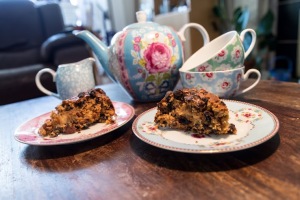
Simnel Cake
Why not try baking a Simnel Cake this Easter weekend? This classic Easter cake is easy to make, and goes well with a cup of tea! I have made mine rather minimalist but feel free to add marzipan decorations, to give it your own flare!
Prep time 30 mins, cook time 1 hr 20. This can be made dairy free.
Ingredients
1 lemon (zest and juice)
500g Mixed Fruit
225g Self Raising Flour
2tsp Mixed Spice
3 large Free Range Eggs
175g Butter/Dairy free alternative
175g Light Muscovado Sugar
Marzipan (Pre made is easiest)
For this use a spring bottom tin (20 inches), for beating either do this by hand or use a food mixer/electric beater (a food proccessor will ruin the sponge mix).
Method
- Put the lemon juice in a saucepan and add all the dried fruit, on a low heat bring the mix to a simmer and let it bubble for 2 minutes – make sure you stir this and watch for the liquid disappearing then remove from the heat and place the mix on a large plate and leave to cool.
- Line the base of a 20 inch loose based deep round cake tin with baking parchment. Preheat the oven to 150 fan / 170.
- Mix the flour and the mixed spice in a large bowl.
- In an electric food mixer, beat the butter and the sugar until light and fluffy looking. Once this is mixed add in the eggs one at a time.
- Now add in the flour mix in batches. Then the fruit, again in batches.
- Take the marzipan and roll it out into a circle about 5mm thick. Make sure it is big enough to touch the sides of the tin. (If you are using a spring bottom tin, remove it and use it as a guide for the size of the marzipan disc)
- Pour 1/2 of the mix into the baking tin, making sure the mix is level, add a disc of the marzipan. Then add the rest of the mix to the tin.
- Bake for 1 hour and 20 mins – it should have risen be firm and golden brown. Once cool glaze with apricot jam which has been heated.
Have fun making this and enjoy your Easter weekend – Catriona McIntosh, Learning Intern 🙂